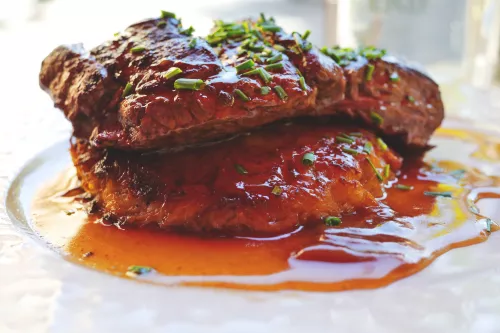Despite the rising cost of food and sanctions pressure, by the end of the year, Russia is expected to increase the consumption of meat, milk, fruits and vegetables. At the same time, not only the amount of food eaten increases. Russians tend to diversify and improve their menu.
In particular, last year's record for meat consumption may be broken this year. Last year it reached 77 kg per person per year, this year it may increase by another 1-2 kg due to an increase in pork production, experts of the Russian Agricultural Bank predict. At the same time, not just the amount of meat eaten is growing: turkey has ceased to be exotic, the consumption of duck, guinea fowl, geese, and quail meat is growing. As a result, the share of traditional chicken, pork, beef fell below 90%.
Consumption of dairy products could rise by 1%, up to 243 kg per person per year. The main driver will be the growth in consumption of cheese and butter. Rosselkhozbank experts attribute this to the development of cheese making in the country. Small producers are experimenting with spices, molds and aging, which attracts buyers.
Due to the emergence of new greenhouses, the consumption of vegetables is growing, including in remote regions of the Trans-Urals and the Far East. In the first quarter, production increased by about 5%. Such dynamics may continue at the end of the year, experts of the Russian Agricultural Bank believe. In addition to the usual cucumbers and tomatoes, the construction of greenhouses for growing peppers, eggplants and garden strawberries is expected. In total, Russians eat 107-108 kg of vegetables per person per year, which roughly corresponds to or even exceeds the level of consumption in most EU countries.
Russians are also eating more and more fruits. This year, consumption could reach 64 kg per person per year. The share of imports remains high at the expense of citrus fruits and bananas, as these cannot be grown in the Russian climate. But after the introduction of the food embargo in 2014, fruits are imported from friendly or neutral countries (Turkey, Ecuador, Azerbaijan, South Africa, Egypt).
Speaking about the trends in the food market in our country, one should not forget about the purchasing power of the population, the director of the Federal Scientific Center for Food Systems named after. V.M. Gorbatov RAS Oksana Kuznetsova. The same meat basket for a reason consists mostly of poultry meat, as the most affordable animal protein in our country. Many meat processors are also increasingly using poultry meat in sausages instead of beef and pork to keep their products available to customers. “All this tells us that consumption growth can be based not on an increase in production as such, but on an increase in the standard of living and well-being of our citizens, first of all. It is processing that most sensitively captures the mood of the consumer,” the expert says.
Unconditional growth in the production of vegetables and fruits in our country will also be difficult to maintain in the absence of purchasing power and cardinal decisions to develop domestic agricultural science and investment activity in the field of domestic seed production, adds Kuznetsova.
© Inline LLC 2015-2025. Privacy Policy | Terms of Service